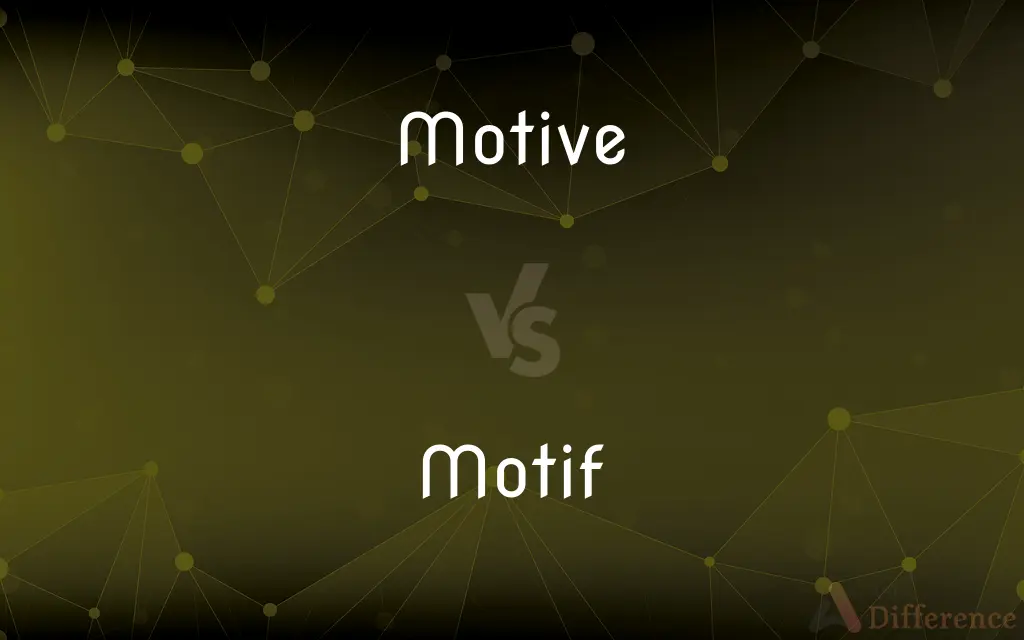Motive vs. Motif — What's the Difference?
By Urooj Arif & Maham Liaqat — Updated on March 15, 2024
Motive is the reason behind an action, driven by desire or need, while a motif is a recurring theme, idea, or element in artistic work, emphasizing patterns or symbols.

Difference Between Motive and Motif
Table of Contents
ADVERTISEMENT
Key Differences
A motive is fundamentally the psychological feature that arouses an organism to action toward a desired goal, serving as the explanation for an individual's actions, desires, and needs. It's the 'why' behind actions, deeply rooted in emotions and logic. Whereas, a motif in literature, art, or music refers to a recurrent thematic element or a repeated symbol that develops or explains a theme, making it a structural component that adds depth and meaning to the work.
Motive is intrinsic to behavioral psychology and is often discussed in the context of criminal investigations, literature, and everyday decision-making, highlighting its relevance in understanding human behavior. On the other hand, a motif is a critical tool in literary and artistic analysis, providing insight into the thematic framework and the artist's intentions, making it a key element in the critique of artistic works.
In the context of literature, a character’s motive is their reason for behaving in a certain way or carrying out an action, which reveals their personality, desires, and ethical compass. Whereas, a literary motif might be a recurring element, such as a type of incident, a reference, or a verbal formula, which helps in building the thematic structure of the work.
In criminal law, understanding a person's motive can be crucial in establishing the reason behind a crime, often influencing the outcome of legal proceedings by providing context for the actions in question. Meanwhile, in the analysis of a piece of art, identifying motifs helps in understanding the underlying messages or themes the artist wants to convey, offering a deeper appreciation of the artistic work.
While motives are deeply personal and subjective, varying greatly from person to person, motifs are more objective and are identified by their repetition and significance within a work, making them a shared experience among its audience.
ADVERTISEMENT
Comparison Chart
Definition
The reason behind an action or behavior, driven by psychological needs or desires.
A recurring theme, idea, or element in an artistic or literary composition, symbolizing a particular theme.
Context
Psychology, law, everyday decision-making.
Literature, art, music.
Nature
Psychological and subjective; varies from person to person.
Structural and objective; identified by repetition and significance in a work.
Purpose
To explain or justify an action or behavior.
To develop or explain a theme, adding depth and meaning to a work.
Examples in Usage
Investigating a crime, analyzing character behavior in literature, understanding motivations in psychology.
Analyzing thematic structures in literature and art, identifying symbols in artistic works.
Compare with Definitions
Motive
A motive is the driving force behind an action.
The detective determined the thief's motive was financial desperation.
Motif
Motifs can be visual, auditory, or thematic.
The motif of birdsong was prevalent throughout the symphony, symbolizing freedom.
Motive
Motives are often rooted in psychological needs.
His motive for volunteering was a deep-seated need for social connection.
Motif
A motif is a recurring element that symbolizes a theme in art.
The recurring motif of water in the novel symbolizes renewal.
Motive
Motives can be complex and multi-layered.
His actions were driven by a motive intertwined with loyalty and ambition.
Motif
In literature, motifs contribute to the depth of the narrative.
The rose motif in the story represented love and its complexities.
Motive
Understanding someone's motive can provide insight into their behavior.
Understanding her motive helped him empathize with her decision.
Motif
Identifying motifs can reveal hidden meanings in art.
The frequent use of the color green was a motif that hinted at envy.
Motive
In literature, characters' motives propel the narrative.
Her motive for betraying the hero was revealed to be revenge.
Motif
Motifs enhance the cohesion of artistic works.
The recurring architectural motifs unified the disparate scenes of the film.
Motive
An emotion, desire, physiological need, or similar impulse that acts as an incitement to action.
Motif
A recurrent thematic element in an artistic or literary work.
Motive
(mōtĭv, mō-tēv) A motif in art, literature, or music.
Motif
A dominant theme or central idea.
Motive
Causing or able to cause motion
Motive power.
Motif
(Music) A short rhythmic or melodic passage that is repeated or evoked in various parts of a composition.
Motive
Causing an action
Motive pleas.
Motif
A repeated figure or design in architecture or decoration.
Motive
(obsolete) An idea or communication that makes one want to act, especially from spiritual sources; a divine prompting.
Motif
A recurrent pattern either of molecular sequence, usually of nucleotides or amino acids in proteins, or of molecular structure that usually corresponds to specific biological activity.
Motive
An incentive to act in a particular way; a reason or emotion that makes one want to do something; anything that prompts a choice of action.
Motif
A recurring or dominant element; an artistic theme.
See how the artist repeats the scroll motif throughout the work?
Motive
A limb or other bodily organ that can move.
Motif
(music) A short melodic or lyrical passage that is repeated in several parts of a work.
Motive
(law) Something which causes someone to want to commit a crime; a reason for criminal behaviour.
What would his motive be for burning down the cottage?
No-one could understand why she had hidden the shovel; her motives were obscure at best.
Motif
A decorative figure that is repeated in a design or pattern.
Motive
A motif.
Motif
(dressmaking) A decorative appliqué design or figure, as of lace or velvet, used in trimming.
Motive
(music) A motif; a theme or subject, especially one that is central to the work or often repeated.
If you listen carefully, you can hear the flutes mimicking the cello motive.
Motif
(crystallography) The physical object or objects repeated at each point of a lattice. Usually atoms or molecules.
Motive
(transitive) To prompt or incite by a motive or motives; to move.
Motif
(chess) A basic element of a move in terms of why the piece moves and how it supports the fulfilment of a stipulation.
Motive
Causing motion; having power to move, or tending to move
A motive argument
Motive power
Motif
(biochemistry) In a nucleotide or aminoacid sequence, pattern that is widespread and has, or is conjectured to have, a biological significance.
Motive
Relating to motion and/or to its cause
Motif
Motive.
Motive
That which moves; a mover.
Motif
In literature and the fine arts, a salient feature or element of a composition or work; esp., the theme, or central or dominant feature;
This motif, of old things lost, is a favorite one for the serious ballade.
The design . . . is . . . based on the peacock - a motif favored by decorative artists of all ages.
Motive
That which incites to action; anything prompting or exciting to choise, or moving the will; cause; reason; inducement; object; motivation{2}.
By motive, I mean the whole of that which moves, excites, or invites the mind to volition, whether that be one thing singly, or many things conjunctively.
Motif
A decorative appliqué design or figure, as of lace or velvet, used in trimming; also, a repeated design.
Motive
The theme or subject; a leading phrase or passage which is reproduced and varied through the course of a comor a movement; a short figure, or melodic germ, out of which a whole movement is develpoed. See also Leading motive, under Leading.
Motif
A design that consists of recurring shapes or colors
Motive
That which produces conception, invention, or creation in the mind of the artist in undertaking his subject; the guiding or controlling idea manifested in a work of art, or any part of one.
Motif
A theme that is elaborated on in a piece of music
Motive
Causing motion; having power to move, or tending to move; as, a motive argument; motive power.
Motif
A unifying idea that is a recurrent element in a literary or artistic work;
It was the usual `boy gets girl' theme
Motive
To prompt or incite by a motive or motives; to move.
Motive
The psychological feature that arouses an organism to action toward a desired goal; the reason for the action; that which gives purpose and direction to behavior;
We did not understand his motivation
He acted with the best of motives
Motive
A theme that is elaborated on in a piece of music
Motive
Causing or able to cause motion;
A motive force
Motive power
Motor energy
Motive
Impelling to action;
It may well be that ethical language has primarily a motivative function
Motive pleas
Motivating arguments
Common Curiosities
Why is understanding motive important in criminal law?
Understanding motive is crucial in criminal law as it helps establish the reason behind a crime, potentially affecting legal outcomes.
Are motives always rational?
Motives can be rational or irrational, influenced by logical reasoning or emotional responses, respectively.
Can motives be subconscious?
Yes, motives can be subconscious, influencing behavior without the individual's conscious awareness.
What is a motif in literature?
In literature, a motif is a recurrent theme, idea, or element that emphasizes a narrative's thematic concerns.
What is a motive?
A motive is the underlying reason that drives an individual to act in a certain way or make a particular decision.
Can the same action have multiple motives?
Yes, a single action can be driven by multiple motives, reflecting the complexity of human behavior and decision-making.
How do motives influence behavior?
Motives shape behavior by influencing decisions, actions, and reactions based on personal desires, needs, or psychological factors.
How do motifs differ from themes?
Motifs are recurring symbols or elements that support themes, while themes are the underlying messages or central ideas of a work.
Why are motifs important in art?
Motifs are important in art as they add depth, create cohesion, and enhance the viewer's or reader's understanding of the theme.
Can a motif appear only once in a work?
By definition, a motif should recur within a work to be considered a motif, although its initial appearance can be significant.
Can motifs be non-visual?
Yes, motifs can be non-visual, such as sounds, words, or actions, contributing to thematic development.
How are motives identified in psychological studies?
In psychological studies, motives are often identified through behavioral observations, self-reports, and psychological tests that analyze underlying desires and needs.
Is a motive always conscious?
No, motives can be both conscious and unconscious, with some driving forces not being fully recognized by the individual.
Are motifs always intentional by the creator?
While motifs are often intentional, some can emerge naturally through the creative process and may not be initially planned by the creator.
Can a motif change meaning throughout a work?
Yes, a motif can evolve and change in meaning throughout a work, reflecting the development of themes or characters.
Share Your Discovery

Previous Comparison
Forthcoming vs. Upcoming
Next Comparison
Spittle vs. SpitAuthor Spotlight
Written by
Urooj ArifUrooj is a skilled content writer at Ask Difference, known for her exceptional ability to simplify complex topics into engaging and informative content. With a passion for research and a flair for clear, concise writing, she consistently delivers articles that resonate with our diverse audience.
Co-written by
Maham Liaqat















































